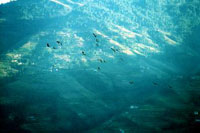




WASHINGTON—In the second part of an in-depth interview with the authors of Lost in Tibet , Miriam Murcutt and Richard Stark, RFA's Tibetan service continued the discussion with their impressions of present-day Tibet.
MM : When the airmen were in Tibet, there were a very, very few representatives of the Chinese government in Lhasa... When we went back to Tibet, which was four years ago, the Chinese presence was obviously very, very visible. In Lhasa, the area around the Jokhang, the temple in Lhasa is the Tibetan old quarter, if you like, and the outskirts of the city, are very much dominated by new Chinese buildings.
RFA : She said the increasing numbers of Chinese in many parts of the high plateau of Tibet, was largely the result of Beijing's deliberate policy of developing the infra-structure by building roads and constructing new buildings in order to facilitate the immigration of as many Chinese as possible into Tibetan areas. Co-author Richard Stark agreed:
RS : It's almost reaching a stage now in some of the major towns where the Tibetans have become minorities in their own country, and in many cases, of course, persecuted minorities in their own country.
RFA : Asked whether or not the experience of the five American airmen had prompted discussion at the time with U.S. government or the secret service about the prospects of setting up air-bases in Tibet, he said:
RS : Well, the Tibetans did try to take advantage of the fact that the American airmen had landed in Tibet, in an attempt to get the American government to recognize that Tibet was an independent country. The Tibetan government argued that the Americans had taken off from China, and so presumably had permission from the Chinese authorities to do that. They then had flown over Tibet, but had not received any permission to fly over Tibet from the Tibetan government."
The Tibetan issue wasn't simply one of great interest to the Americans, who were far more involved in keeping the Chinese as an ally.
RFA :Speaking on the same subject, Murcutt said she felt that the American interest in Tibet was just accidental, and that before World War II America had no significant direct contact with Tibet.
MM : Oh, I think that the U.S. had only peripherally taken an interest in Tibet. They really had had no great link with the country before the War and they became interested because they were. Of course, China was on the Allied side. China was fighting the Japanese, and America needed to get supplies from India into China to help support the Chinese war effort.
RFA :In order to transport the military supplies to China from India, there were only two alternatives—either to fly them over the "Hump" of the high Tibetan plateau, or to build a new road through Tibet. As Washington had a vested interest in the road option, the U.S. Government dispatched [envoys] to seek permission to build new roads. Prior to that, the U.S. government had not paid any particular attention to Tibet because it wasn't politically or strategically significant.
RS : But at that time, as Miriam says, the Tibetan issue wasn't simply one of great interest to the Americans who were far more involved in keeping the Chinese as an ally; keeping the fight against the Japanese… and basically pushing as hard as they could to win the Second World War. So the issue of Tibet was very, very small to create any kind of impact on the American horizon.
RFA : The two authors were also able to visit and consult many documents written by the five airmen about their time in Tibet, now lodged in the U.S. National Historical Archives. More importantly, they were able to consult many natural history documents at the British Library where the then permanent British Representative in Lhasa had filed reports to the British government relating to the case.
MM : We were actually very lucky in the wide ranging number of resources that were available to us. First of all we went to the U.S. Air Force Historical Research Agency, and they had declassified information that the airmen had actually provided them with... immediately after they had come out of Tibet. Even though we were doing this book so many years later, it was reading a report that was in fact written a few weeks after the airmen had in fact been through the experiences in Tibet. So, it was very, very clear and vivid.
RFA : Through the documents the two authors were able to gain a clear understanding of the status of the then relationship among Britain, the United States, China, and Tibet. They also contacted surviving children and relatives of the five American airmen who had long since died, and managed to get hold of numerous personal records.